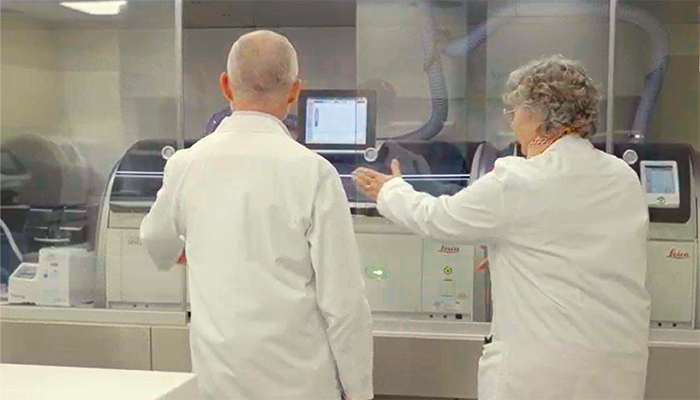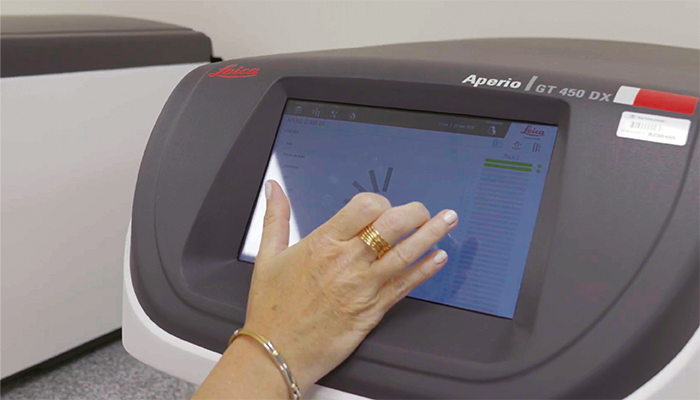
In this follow-up to our three-part series showcasing how pathology laboratories in New Zealand, Germany, and Portugal have successfully tackled the transition to digital, Rob Monroe, Chief Medical Officer at Leica Biosystems, highlights the efforts to build a successful digital pathology laboratory at Institut Curie in France.
Institut Curie was founded in 1909 and today treats more cancer patients than any other center in France, as well as more breast cancer patients than any center in Europe. Now, more than a century after it was founded, the medical center and its affiliated institutions are also leading France in digital transformation.
Institut Curie boasts two hospitals and a research arm. Yves Allory, Head of Pathology at the Institute’s hospital in Saint-Cloud, notes that digital tools will help Institut Curie embrace cutting-edge research for years to come. “I see many, many advantages for us. I think it’s our future.”
Initially, though, Allory had his doubts about the clinical adoption of digital pathology. “I was afraid that people would stay in their own offices without spending time talking together,” he says. However, the opposite happened – the digital approach enhanced teamwork, allowing Institut Curie’s locations to share cases and reach diagnoses faster, ultimately benefiting patients.
Instrument selection
Institut Curie’s pathology labs began their digital transformation with a high-quality scanner. Instead of sharing physical glass slides, the labs now scan and distribute virtual slides digitally, streamlining storage and distribution but adding a step for technicians. “Simplicity for the technicians is important,” says Lab Manager Magalie Toutain. Image quality was crucial, and the scanner needed to fit seamlessly into workflows. The lab selected the Leica Biosystems Aperio GT 450 scanner, which Allory says is “very easy to use for the technician and produces high-quality images for the pathologist.”

Workflow design and optimization
Next, the Institut Curie partnered with vendors to map out its entire workflow, covering pre-analytic processes, scanning, image quality control, virtual slide distribution, and instrument maintenance. “It’s important that you put a lot of energy into optimizing all these steps,” observes Allory.
Much like traditional pathology, however, a successful digital transformation still depends on strong pre-analytics. The new scanner required meticulously prepared glass slides, with consistent histologic sectioning. “The sections must be correct, without folds, without holes,” emphasizes Toutain, who notes that the lab examined and refined every step of their process, including analog practices, to ensure digital success.
The digital transformation team ensured all key stakeholders were involved. “It is very important to have the lab technician, the histotechnologist, the lab manager, the pathologist, and the IT department,” says Allory. They also collaborated closely with vendors to plan the project thoroughly.
Starting small was essential. Toutain highlights the importance of trusted vendor partnerships and implementing one tool successfully before scaling up. Initially, introducing the Leica Biosystems Aperio GT 450 scanner felt daunting. However, collaboration among internal teams and external partners made the transformation a success, and served to simplify the ongoing maintenance, service, and support.
The lab then added a Leica Biosystems HistoCore SPECTRA Workstation for H&E staining. Toutain describes the staining workflow as straightforward and easily adaptable to the pathologists’ expectations. “Maintenance is very important in the workflow, but everything runs optimally,” she notes.
With a streamlined digital workflow, the lab’s hospitals and research arm can collaborate more efficiently and review cases quickly. The transition to digital also brings additional benefits. Remote work is now an option for some staff, helping them to balance their work and personal lives. Further, Allory points out that remote flexibility can attract qualified staff and address the broader shortage of pathologists.
To the future
As Institut Curie looks to the future, it's clear that digitization is key. Storing slides digitally reduces the need for physical storage and transportation, helping to minimize waste and lower the lab’s carbon footprint, according to Allory. Moreover, as Toutain highlights, digitization lays the groundwork for adopting AI technologies in both clinical and research settings. AI enables labs to leverage their data for innovative solutions while delivering more accurate and timely diagnoses.
Building on its history of innovation – beginning with the introduction of radium for cancer therapy – Institut Curie’s digital transformation could now help to shape the future of pathology in France.




